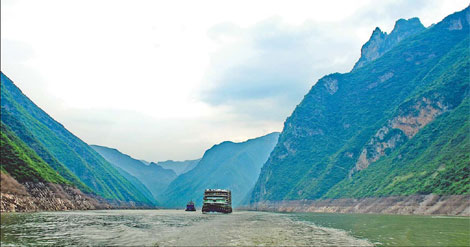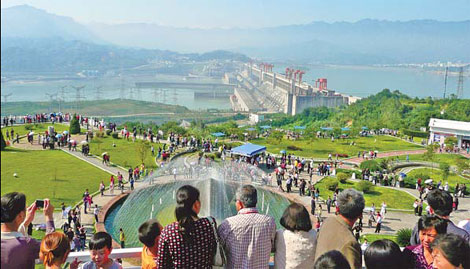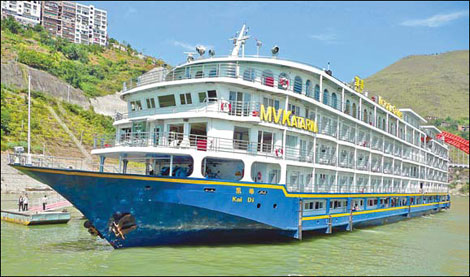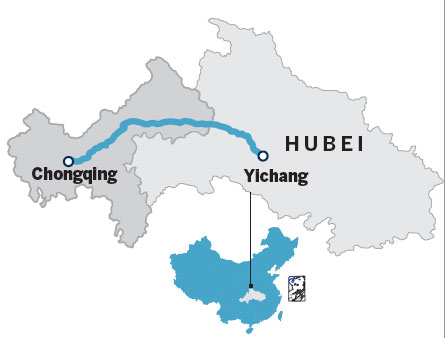Share Your Experience
Cruising down the Yangtze River
Updated: 2010-11-04 09:21
By Freddie Cheah (China Daily)



It's a changed landscape along the banks of the Yangtze, raised 100 meters in some sections after the Three Gorges Dam started operating. Freddie Cheah looks at the new views.
Cruising on the Yangtze River - sometimes called the cradle of Chinese civilization - evokes a strange feeling. Here is a river where for thousands of years, millions lived along the shores in small houses. Now there are no signs of these ancient homes and instead, hundreds of high-rise apartment blocks and dozens of small shipyards and factories line the banks. The sad truth is, those centuries-old mud-brick homes are now under water, submerged since the Three Gorges Dam began backing up water in 2003.
But that realization is about the only blemish on an otherwise great cruise up the Yangtze River on the Victoria Katarina, one of eight ships operated by the New York-based Victoria Cruises.
At first glance, the 5,780-ton Katarina, built in 2004 but refurbished earlier this year, looks a bit tired and old-fashioned. Its slab-like side, rising from the blue and yellow bow, appears to be more apartment block than cruise ship. It doesn't conjure up the image of a sophisticated cruise ship offering a fun-filled and carefree voyage, with passengers sipping cocktails on an open deck before sauntering off to a sumptuous four-course dinner.
But that doesn't do the ship justice. Board the 98.6-meter-long Katarina, climb one flight of stairs and the vista of an inviting and well-decorated lobby greets incoming passengers. Indeed, its opulence reminded me a bit of the lobbies of ocean-going cruise ships that I've been on - and cocktails on the open deck and a four-course dinner were part of the deal.
Our "superior cabin" - up one level from the basic - was spacious, with a lounge chair in front of a large flat-screen TV. A partition blocked off the king-sized bed, which also had a smaller flat-screen TV. Like all other cruise ships we've been on, the cabin was spotlessly made-up every morning.
Its four levels of cabins have floor-to-ceiling glass doors leading to private balconies - unlike some other cruise ships we saw plying the Yangtze - and even a bathtub in the en suite.
Except for the cruise director and his assistant, all the ship's staff are from China, and without exception provided attentive and friendly service to its 264 passengers. There was also an air of informality throughout; even officers on the bridge were casually dressed.
We boarded the Katarina at Yichang, Hubei province in Central China, after a hair-raising 20 km taxi ride, with the cabbie swerving and squeezing in traffic, using up every bit of road and shoulder.
Thankfully, the Yichang driver got us to the ship without hitting anything, and with our luggage jammed into the cab's small trunk - and jutting precariously out - intact.
After that, we were prepared for anything the Katarina could dish out, including a ride on a choppy rough river.
But the Yangtze in early October is calm, and it was smooth sailing all the way.
One highlight of the cruise has to be the Three Gorges Dam, the world's largest. The water level of the dam on its reservoir side is about 110 meters higher than river. To get the huge number of ships plying the river to "climb" the dam involves using a five-stage ship lock.
The process is simple: Ships enter the lowest lock, the huge gate behind them is closed, and water is pumped in to raise the vessels to the level of the next lock. The gate in front is then opened, the ships move into the next lock, and the process is repeated until the ships reach the reservoir side. The entire process takes about four hours.
We were due to enter the first lock about 12:30 pm, but heavy river traffic delayed us for several hours. This meant we didn't complete the climb until after sunset, depriving us of a view of the reservoir in daylight.
Going through the huge locks was a great experience. There was no sensation of rising, only the sight of the locks' walls slowly moving downward confirming our ascent. Once through, the reservoir and river stretch all the way to the southwestern city of Chongqing, our final destination, more than 600 km away.
But that was still four days sailing, giving us the chance to see quite a bit of the Yangtze, including the beautiful and awe-inspiring Qutang, Wu and Xiling gorges that make up what's known as the Three Gorges.
There were shore excursions to visit the dam site, a tributary of the Yangtze - and more gorges - on smaller boats and Fengdu, which became known as Ghost City in the Tang Dynasty (AD 618-907) and is billed as the river's top attraction.

Fengdu's temples, built on top of Mingshan Mountain, are hundreds of years old, with macabre displays of what can happen to cruel people after death. Visitors face a steep climb of hundreds of steps, though the more faint-hearted can opt for a chairlift that will take them halfway up the hill, which is about 290 meters high.
With the river about 175 meters above sea level, the walk up is not too bad. But I couldn't help thinking that before the dam submerged the old town of Fengdu and the riverbank was at least 100 meters below today's level, worshippers had an even more strenuous climb.
Back on board, the pace is more leisurely, with Katarina's attentive staff not only providing top-class service, but also the nightly entertainment. For example, our dining room waitress, Vivian Wang, modeled costumes from various Chinese dynasties, danced and even played a musical instrument at the two after-dinner shows.
And even the ship's cruise director, Christof von Zieten, proved to be a somewhat droll comedian, telling passengers during the safety briefing that the life-vest has a whistle to attract attention - or to order a beer.
Specials

President Hu visits the US
President Hu Jintao is on a state visit to the US from Jan 18 to 21.

Ancient life
The discovery of the fossile of a female pterosaur nicknamed as Mrs T and her un-laid egg are shedding new light on ancient mysteries.

Economic Figures
China's GDP growth jumped 10.3 percent year-on-year in 2010, boosted by a faster-than-expected 9.8 percent expansion in the fourth quarter.